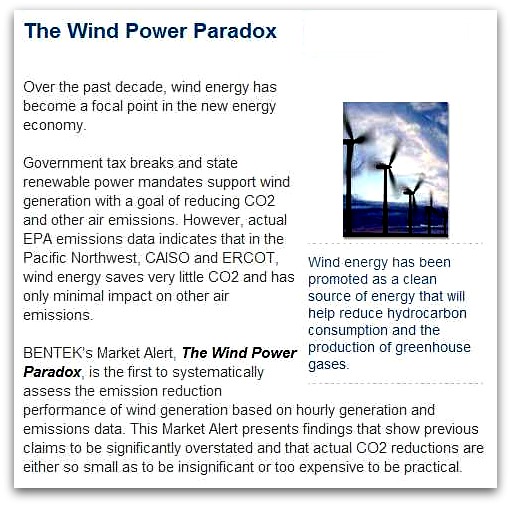Wind energy is the “equivalent of the corn ethanol scam” (Bentek Report)
Aug 24, 2011
·
—Randall J. Bell, President, Victorian Landscape Guardians Inc (Australia)
You could be forgiven for wondering why the wind industry and its cheer squad, the Australian Clean Energy Council (which is NOT a Government agency), is going ballistic lashing out at opponents of wind farms.
The reason is simple: the public is waking up to some inconvenient truths about wind.
What happens when there is no wind? There is no electricity. What happens when the wind is too strong and the turbines have to be braked? There is no electricity. What happens when the wind fluctuates wildly and the wind farm is “kicked” off the grid because of surging? There is no electricity, unless it comes from coal or gas fired generators (perhaps a little bit of hydro) which have to be in “hot spinning reserve” constantly shadowing these events. And this is at the cost of consumers at least three times the cost of coal-fired and twice the cost of gas-fired electricity.
But the news gets worse for the industry—which suffered a 7% fall in sales in Europe last year and the continued withdrawal of subsidies—with the release of a new study on 19 July 2011 by USA, Colorado-based energy analytics firm Bentek Energy, discussed in Forbes Magazine 7/19/11.
 … from the Bentek website
… from the Bentek website
The Bentek study carries considerable authority because it dealt with real data not computer models and “covered about 110 million customers, or about one-third of the U.S population in four regions.”
Because of space I will quote selectively from the article:
… the American Wind Energy Association (AWEA) and other wind boosters have vastly overstated wind’s ability to cut sulfur dioxide, nitrous oxide, and carbon dioxide.” In California “using wind energy doesn’t reduce sulfur dioxide emissions at all.”
“But the most important conclusion from the study is that wind energy is not “a cost effective solution for reducing carbon dioxide…”
“Wind’s energy carbon dioxide-cuttings benefits are vastly overstated”
“…The study undercuts the sector’s reason for existing.”
But here is the killer quote. “The wind energy business is the electric sector’s equivalent of the corn ethanol scam: it’s an over-subsidized industry that depends wholly on taxpayer dollars to remain solvent while providing an inferior product to consumers that does little, if anything, to reduce our need for hydrocarbons or cut carbon dioxide emissions.”
·



Comment by Karen Bessey Pease (Kaz) (Maine) on 08/24/2011 at 4:31 pm
The wind industry and some of their most fervent supporters here in Maine, such at the Natural Resources Council of Maine, completely discount both Bentek studies, due to the fact that Bentek’s “business” is in fossil fuels. They dismiss it by stating it is biased. With no reasonable defense, what else can they do?
The wind industry is cornered and feeling defensive, and as a result they will go on the offense. We can expect to see some type of study countering Bentek’s, I feel sure.
Common sense says that industrial wind facilities are not reducing greenhouse gasses by an appreciable amount—especially when ALL aspects are taken into consideration. The ecological/environmental damage, the manufacturing process (often in China, where there are few emissions standards), the transportation to ship these around the world…but for decades, citizens have been brainwashed. Some call it “greenwashed.” We’ve listened to the “wind spin” and swallowed the “green” argument without questioning it.
We are all guilty of not doing our homework, but we can no longer afford to ignore this important issue. Thank you for providing this resource.
Kaz

.
Comment by Young Ng, Association for Geoconservation, Hong Kong on 08/24/2011 at 5:10 pm
Thanks. This is a great report.
Look forward to seeing more reports like this.
Cheers,
Young
Comment by Willem Post on 08/24/2011 at 6:56 pm
It is about time some reports come out refuting the PR hype of wind aficionados.
Here in Vermont the Green Mountain Power-proposed 63 MW Lowell Mountain wind turbine facility with (21) 3 MW Danish, Vestas V-112 wind turbines, 373-ft (112 m) rotor diameter, 280-ft (84 m) hub height, total height (280 +373/2) = 466.5 ft, stretched along about 3.5 miles of ridge lines, has nothing to do with community-scale wind, everything with industrial, utility-scale wind. The housings, 13 ft x 13 ft x 47 ft (3.9 m x 3.9 m x 14 m), on top of the 280-ft towers, are much larger than a Greyhound bus.
The GMP name for this facility is “Kingdom Community Wind”. GMP is using blatantly deceptive PR to soft-soap/deceive Vermonters.
http://energy.worldconstructionindustrynetwork.com/news/ … (click here)
http://www.vestas.com/Files/Filer/EN/Brochures/Vestas_V_112_web_100309.pdf
The wind energy production would be about 63 MW x 1 GW/1,000 MW x 8,760 hr/yr x capacity factor 0.32 = 176.6 GWh/yr, or 176.6/6,000 x 100% = 2.94% of Vermont’s annual consumption.
The capital cost of the wind turbine facility would be at least 63 MW x $2,500,000/MW = $157.5 million, excluding grid modifications.
The Lowell wind turbine facility facility would have a 20 – 25 year useful service life. However, gearboxes and blades sometimes fail within 5-10 years.
For the Lowell wind turbine facility, the balancing energy would be 63 MW x 1 GW/1,000 MW x 8,760 hr/yr x (1.0 – 0.32) = 375.3 GWh/yr, or 375.2/6,000 x 100% = 6.25% of New England’s annual consumption. It would be produced by the balancing plants at an efficiency that is significantly less than if the same plants were operated at their best efficiency which occurs at rated output, in base-loaded mode.
In fact, the wind energy PLUS balancing energy could be produced by just the balancing plants, if operated at rated output, in base-loaded mode. Only a small quantity of additional fuel/kWh would be needed AND only a small quantity of additional CO2 emissions/kWh would result, which begs the question: why is wind energy needed at all?
http://theenergycollective.com/willem-post/53258/examples-wind-power-learn

http://theenergycollective.com/willem-post/57905/wind-power-and-co2-emissions
http://theenergycollective.com/willem-post/59747/ge-flexefficiency-50-ccgt-facilities-and-wind-turbine-facilities
http://theenergycollective.com/willem-post/61309/lowell-mountain-wind-turbine-facility-vermont
http://theenergycollective.com/willem-post/61774/wind-energy-expensive
.
Willem Post
Comment by jack sullivan on 08/28/2011 at 9:22 am
In a comparison study spanning 5 years, I found the wind promises before and the actual outcomes after were very different. The wind developers either exaggerated or outright lied about their claims.
Mr. Post is correct in stating the insignificant impact Lowell Mt. project will have on Vermont’s electricity production. However, it may be even less since Vermont has approximately the same wind potential as NY and the avg. Capacity Factor of 15 NY wind projects last year was 22%. Definitely NY and Vermont industrial wind is a LOSER!
Jack Sullivan, M.S. Physics (Cornell)

.
Jack Sullivan, MS (Physics, Cornell University)
Town Councilman, Malone, NY